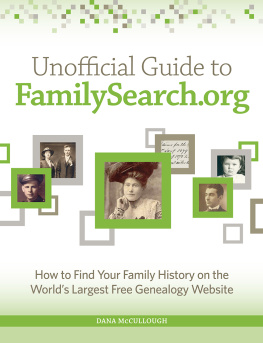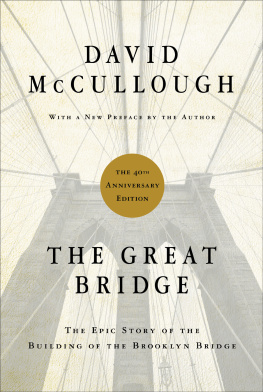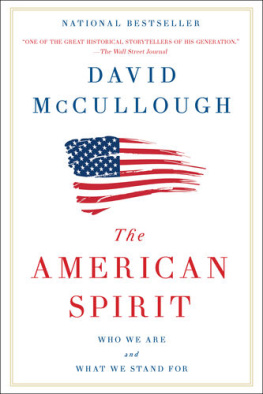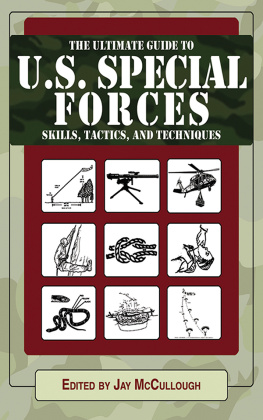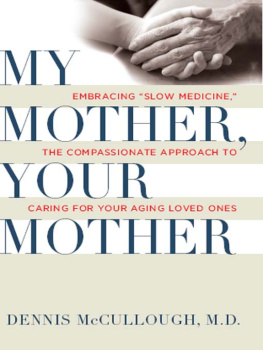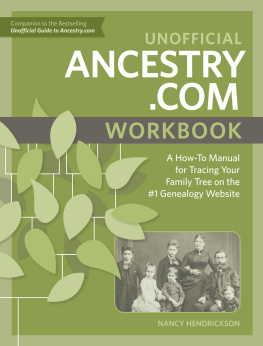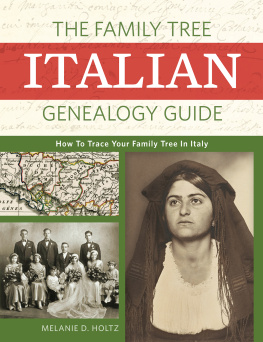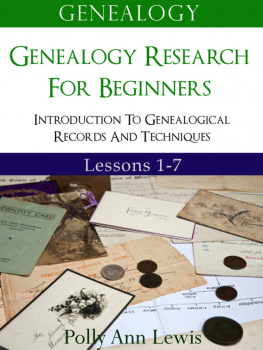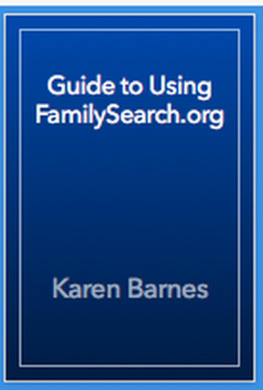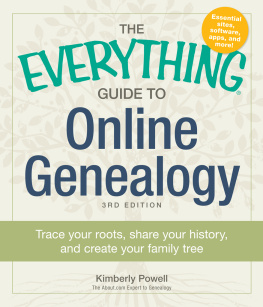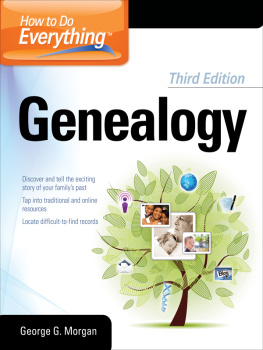Contents
Guide
Unofficial Guide to FamilySearch.org
How to Find Your Family History on the Worlds Largest Free Genealogy Website
Dana McCullough

Cincinnati, Ohio
shopfamilytree.com
DEDICATION
To my late grandfather Harold Schmidt and grandmother Henrietta Gemignani Spanos. I am so grateful to have had you in my life and to have learned your stories of courage and bravery. You are my inspiration.
CONTENTS
CHAPTER 1
GETTING STARTED
Get acquainted with FamilySearch.org and learn genealogy basics to set yourself up for success.
CHAPTER 2
THE FAMILYSEARCH FAMILY TREE
Learn how to find new ancestors in FamilySearch.orgs giant user family tree, as well as how to create and manage your own family tree on the website.
CHAPTER 3
SEARCHING AND BROWSING HISTORICAL RECORDS
Discover tips and strategies to mine the billions of ancestors in FamilySearch.orgs Historical Records collections.
CHAPTER 4
SEARCHING GENEALOGIES, THE CATALOG, AND BOOKS
Move beyond the main search form to uncover genealogy clues in the Ancestral File, Pedigree Resource File, International Genealogical Index, FamilySearch Catalog, and a massive archive of digitized family history books.
CHAPTER 5
US CENSUS RECORDS
Count on the tips in this chapter to find your ancestors in FamilySearch.orgs collections of federal, state, and special censuses.
CHAPTER 6
US VITAL RECORDS
Revitalize your search for vital statistics on FamilySearch.org. This chapter walks you through the sites birth, marriage, and death collections.
CHAPTER 7
US IMMIGRATION AND NATURALIZATION RECORDS
Sail to new discoveries about your immigrant ancestors journey to America and to citizenship. Youll learn how to locate passenger lists, naturalizations, and more.
CHAPTER 8
US MILITARY RECORDS
Learn strategies to conquer record collections from the American Revolution through World War II (and beyond)plus get a debrief on records from draft cards to pension files.
CHAPTER 9
US PROBATE AND COURT RECORDS
Get pointers for probing into state and local collections with probate files, land records, naturalizations, tax records, voter lists, and more.
CHAPTER 10
EUROPEAN RECORDS
Trace your family tree across the pond in FamilySearch.orgs growing European record collections. This chapter walks you through available collections and strategies to use them.
CHAPTER 11
GLOBAL RECORDS
Take your genealogy search into Canada, Mexico, Latin America, and all around the world with helpful hints and background information on FamilySearch.org collections, country by country.
CHAPTER 12
MORE HISTORICAL RECORDS
Discover the genealogical gems you can unearth within the Miscellaneous and Other categories of Historical Records on FamilySearch.org.
APPENDIX A
THE FAMILYSEARCH WIKI
APPENDIX B
FAMILYSEARCH INDEXING PROJECTS
APPENDIX C
RESEARCH WORKSHEETS
INTRODUCTION
Since I was a young girl, Ive always believed that family is important. I was first exposed to genealogy research in the fifth grade during a school assignment to research my family history. I put together a video presentation I called Ancestral Journal that showcased what little I knew then about my family history. The video showed me playing the role of a news anchor, reading stories I learned from interviewing relatives about their childhood memories, sifting through family photographs, and gathering family heirlooms and old letters from relatives.
Today, I believe this early experience was a foreshadowing of what was to come in my life. I graduated from college with a degree in journalism (the print kind, not the broadcast kind) and started working at Family Tree Magazine. While at the magazine, my interest in researching my family history blossomed. It was also where I was first introduced to FamilySearch.org .
Over the years, FamilySearch.org has become my go-to genealogy research website. Its usually the first place I turn to research records for a specific ancestor for two reasons: Its free, and it has an extensive (and continually growing) digital records collection.
FamilySearch.org is where Ive found federal and state census records and transcriptions for both my ancestors and my husbands. Its where I found the naturalization record for my great-grandfather, who immigrated to America from Italy in the early 1900s. Its also where Ive found birth, death, and marriage records for several ancestors. In addition, because of FamilySearch.org, I learned that my grandmother worked as a maid before she got married, and I learned the year that some of the relatives on my dads side of the family came to America. All of the records and information I have found have provided clues to my ancestors lives and given me a deeper sense of who my ancestors were, as well as when and where they lived.
Through my work with Family Tree Magazine as an assistant editor and later as a freelance writer and editor, I learned that many genealogists (especially beginners) dont know about FamilySearch.orgor their knowledge only scratches the surface. Although its got billions of records, FamilySearch.org is a hidden gem, an underutilized resource. Ive come to find this online resource extremely valuable, and because of that, I want to share my knowledge and experience of this website with other genealogy enthusiasts. Its a website I think every genealogist should know about and use.
As you research your own family, I hope the tips and insights in this book help you fine-tune your searches to locate a genealogy gold mine of records for your ancestors. Of course, any technology or website can change rapidly, and FamilySearch.org is no exception. From my research conducted for this book, I know that FamilySearch.org is continually working to enhance its website and the search features it offers. Although certain features, search options, and record collections may change after publication, the strategies included should be adaptable to new iterations of the site and search forms. Further, the insights and success stories provided by genealogists throughout the book can serve as inspiration to start (or continue) your ancestor search on FamilySearch.org.
I hope you enjoy the book and find it useful. Happy searching!
Dana McCullough
Milwaukee, Wisconsin
April 2015
Getting Started
Former president Jimmy Carter was once quoted as saying, Weve uncovered some embarrassing ancestors in the not-too-distant past. Some horse thieves, and some people killed on Saturday nights. One of my relatives, unfortunately, was even in the newspaper business.
As this quote illustrates, you never know where your genealogy research journey will take you or whom youll find in your family tree. That said, FamilySearch.org is a great place to start your journey. This free website, operated by The Church of Jesus Christ of Latter-day Saints (LDS), has more than 3.5 billion names in searchable collections. Each month, it adds another thirty-five million records. This amazing amount of online records is largely thanks to FamilySearch, the genealogy arm of the LDS church, and its volunteer indexers and digitizers around the world.
WHATS ON FAMILYSEARCH.ORG?
FamilySearch.orgs main treasures are its family trees, historical records, genealogies, and digitized books. It also has user-submitted Memories, which are photos, stories, and documents posted to the website by registered users. Heres a quick overview of the most important categories and features of FamilySearch.org.

